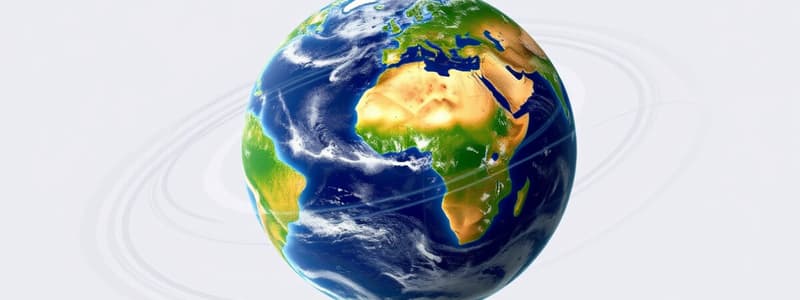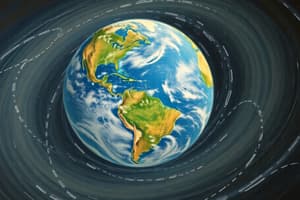Podcast
Questions and Answers
What is the primary effect of the Earth's rotation?
What is the primary effect of the Earth's rotation?
- Rotation of the Moon
- Occurrence of day and night (correct)
- Variation in temperature
- Creation of seasons
Who proved that the Earth is not stationary but rotates on its axis?
Who proved that the Earth is not stationary but rotates on its axis?
- Galileo Galilei
- Isaac Newton
- Nicolaus Copernicus (correct)
- Kepler
The duration of one complete rotation of the Earth constitutes what?
The duration of one complete rotation of the Earth constitutes what?
- A year
- A week
- A month
- A day (correct)
What movement refers to the Earth's orbital motion around the Sun?
What movement refers to the Earth's orbital motion around the Sun?
Which of the following explains seasonal changes on Earth?
Which of the following explains seasonal changes on Earth?
What observation did ancient people make about the Sun?
What observation did ancient people make about the Sun?
Which point of the Earth’s axis is located in the northern hemisphere?
Which point of the Earth’s axis is located in the northern hemisphere?
The Coriolis effect is primarily a result of what process?
The Coriolis effect is primarily a result of what process?
What causes the alternation of day and night on Earth?
What causes the alternation of day and night on Earth?
What is the speed of Earth's rotation at the equator?
What is the speed of Earth's rotation at the equator?
How does the Earth's axial inclination affect the poles?
How does the Earth's axial inclination affect the poles?
What effect does the Earth's rotation have on ocean currents?
What effect does the Earth's rotation have on ocean currents?
Which of the following is NOT affected by the Earth's rotation?
Which of the following is NOT affected by the Earth's rotation?
What is the direction of the Earth's rotation?
What is the direction of the Earth's rotation?
What happens to the appearance of celestial bodies from a point on Earth's surface?
What happens to the appearance of celestial bodies from a point on Earth's surface?
During which season does most of the sunlight occur, especially away from the equator?
During which season does most of the sunlight occur, especially away from the equator?
What shape does the Earth take due to its rotation?
What shape does the Earth take due to its rotation?
What phenomenon is caused by the Earth's rotation that affects air currents?
What phenomenon is caused by the Earth's rotation that affects air currents?
How long does the Earth take to complete one revolution around the Sun?
How long does the Earth take to complete one revolution around the Sun?
What term describes the point in the Earth's orbit when it is closest to the Sun?
What term describes the point in the Earth's orbit when it is closest to the Sun?
What causes high and low tides on Earth?
What causes high and low tides on Earth?
What is the mean distance between the Sun and the Earth?
What is the mean distance between the Sun and the Earth?
Which angle does the Earth's axis tilt relative to the plane of the ecliptic?
Which angle does the Earth's axis tilt relative to the plane of the ecliptic?
When does the Northern Hemisphere experience the longest day?
When does the Northern Hemisphere experience the longest day?
What effects are caused by the revolution of the Earth?
What effects are caused by the revolution of the Earth?
What celestial object does the Earth's axis always point towards?
What celestial object does the Earth's axis always point towards?
At what time does the Sun shine directly above the equator?
At what time does the Sun shine directly above the equator?
What is the speed of the Earth as it revolves around the Sun?
What is the speed of the Earth as it revolves around the Sun?
Which hemisphere has longer nights on 21 June?
Which hemisphere has longer nights on 21 June?
Which statement accurately describes the Antarctic Circle?
Which statement accurately describes the Antarctic Circle?
What occurs in the region from the Arctic Circle to the North Pole?
What occurs in the region from the Arctic Circle to the North Pole?
What is unique about the equator in terms of day and night?
What is unique about the equator in terms of day and night?
How does the length of the day vary with latitude in the Southern Hemisphere?
How does the length of the day vary with latitude in the Southern Hemisphere?
What happens to the length of day in the Northern Hemisphere during winter?
What happens to the length of day in the Northern Hemisphere during winter?
What causes the change of seasons on Earth?
What causes the change of seasons on Earth?
On which date is the vernal equinox observed in the Northern Hemisphere?
On which date is the vernal equinox observed in the Northern Hemisphere?
What is the primary characteristic of the summer solstice?
What is the primary characteristic of the summer solstice?
Which two positions of the Earth are known as solstices?
Which two positions of the Earth are known as solstices?
What happens during the equinoxes?
What happens during the equinoxes?
Which date is known as the autumnal equinox in the Northern Hemisphere?
Which date is known as the autumnal equinox in the Northern Hemisphere?
What phenomenon does the Earth's revolution cause?
What phenomenon does the Earth's revolution cause?
On 22 December, which hemisphere experiences the winter solstice?
On 22 December, which hemisphere experiences the winter solstice?
What causes the variation in the length of day and night on Earth?
What causes the variation in the length of day and night on Earth?
During which event does the Northern Hemisphere experience its longest day and shortest night?
During which event does the Northern Hemisphere experience its longest day and shortest night?
On which date do all places along the equator experience a length of day and night of 12 hours?
On which date do all places along the equator experience a length of day and night of 12 hours?
What happens in the Northern Hemisphere from 22 June to 22 September?
What happens in the Northern Hemisphere from 22 June to 22 September?
What occurs during the equinoxes?
What occurs during the equinoxes?
During which event does the Northern Hemisphere experience its longest day?
During which event does the Northern Hemisphere experience its longest day?
What is the date when the Autumnal equinox occurs in the Northern Hemisphere?
What is the date when the Autumnal equinox occurs in the Northern Hemisphere?
What is the length of day at the Arctic Circle on 21 June?
What is the length of day at the Arctic Circle on 21 June?
During the Winter solstice, which pole is inclined towards the Sun?
During the Winter solstice, which pole is inclined towards the Sun?
What happens to the Arctic Circle during the Summer solstice?
What happens to the Arctic Circle during the Summer solstice?
What is the significant change in day length at the equator on 21 March?
What is the significant change in day length at the equator on 21 March?
Which latitude experiences 12 hours of daylight on 21 June?
Which latitude experiences 12 hours of daylight on 21 June?
Which of the following features occurs on the date of 21 March?
Which of the following features occurs on the date of 21 March?
What condition is experienced at the Antarctic Circle on 22 December?
What condition is experienced at the Antarctic Circle on 22 December?
What characterizes the Southern Hemisphere during the Summer solstice?
What characterizes the Southern Hemisphere during the Summer solstice?
What does the circle of illumination do during the equinoxes?
What does the circle of illumination do during the equinoxes?
Study Notes
Rotation of the Earth
- The Earth rotates from west to east, completing one rotation in approximately 24 hours, resulting in the cycle of day and night.
- The rotational axis is an imaginary line with endpoints at the North and South Poles, tilted at an angle of 66.5° to the plane of its orbit around the Sun.
- Rotation leads to the Coriolis effect, affecting weather patterns and the movement of ocean currents.
- The Earth's shape is an oblate spheroid due to rotation, causing it to bulge at the equator and flatten at the poles.
Speed of Earth's Rotation
- Speed varies by latitude, reaching a maximum of 1669.9 km/h at the equator and decreasing to 0 km/h at the poles.
Effects of Earth's Rotation
- The alternate occurrence of day and night, affected by sunlight illumination on the Earth's surface.
- The rotation causes the flattening at the poles, influencing Earth's overall shape.
- Time zones are established based on the Earth's rotation, coordinating local times with the Sun’s position.
Revolution of the Earth
- The Earth revolves around the Sun in an elliptical orbit, taking approximately 365.242 days to complete one revolution, leading to the occurrence of leap years every four years.
- The average speed of revolution is about 30 km/s, with significant variations in distance from the Sun during perihelion (closest point) and aphelion (farthest point).
Effects of Earth's Revolution
- Seasons result from the combination of Earth's axial tilt and its revolution around the Sun, leading to variations in sunlight and temperatures.
- The length of day and night changes throughout the year, particularly noticeable at higher latitudes due to the axial tilt.
Key Dates in Earth's Revolution
- Equinoxes: On 21 March (spring) and 23 September (autumn), day and night are of equal duration globally.
- Solstices: On 21 June (summer) and 22 December (winter), the Sun is directly overhead at the Tropic of Cancer and Tropic of Capricorn, respectively, creating the longest and shortest days of the year.
Seasonal Changes
- The axial tilt causes half of the Earth to receive more sunlight at different times of the year, leading to distinct seasons:
- Spring Equinox (21 March): Equal day and night, marking the transition to warmer months in the Northern Hemisphere.
- Summer Solstice (21 June): Northern Hemisphere experiences the longest day; maximum solar intensity.
- Autumnal Equinox (23 September): Equal day and night again, transition into cooler months.
- Winter Solstice (22 December): Southern Hemisphere has the longest day; Northern Hemisphere experiences the shortest day.
Notable Geography and Effects
- The Arctic Circle experiences 24 hours of darkness during the winter solstice, while the Southern Hemisphere's Antarctic Circle experiences continuous daylight.
- At the equator, day and night durations remain relatively constant throughout the year.
Additional Information
- Ancient beliefs erroneously posit that celestial bodies revolve around a stationary Earth; this was corrected by Nicolaus Copernicus in the 16th century.
- Due to variations in orbit and rotation, exact dates of equinoxes and solstices can vary slightly from year to year.
Studying That Suits You
Use AI to generate personalized quizzes and flashcards to suit your learning preferences.
Description
Explore the mechanisms of Earth's rotation and revolution in this quiz. Understand phenomena such as day and night cycles, seasonal changes, and the Coriolis effect. Test your knowledge on how these processes affect life on Earth.




